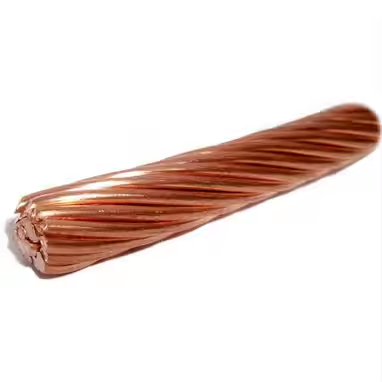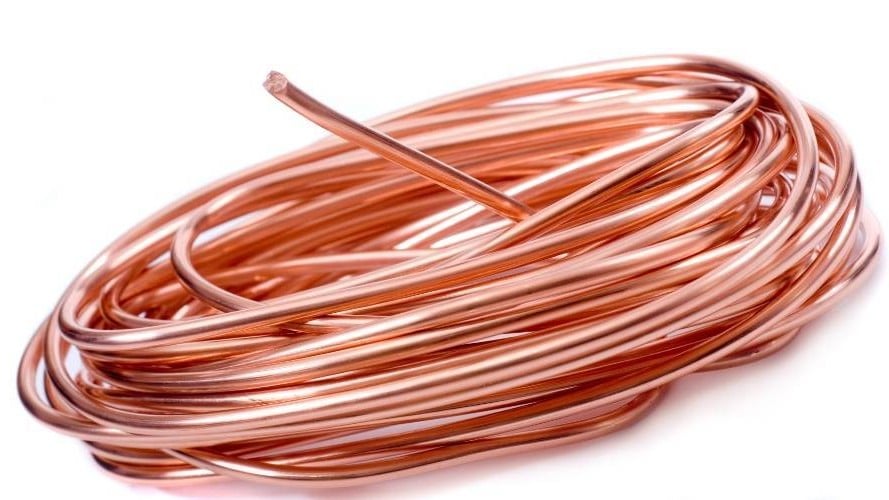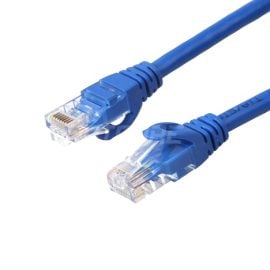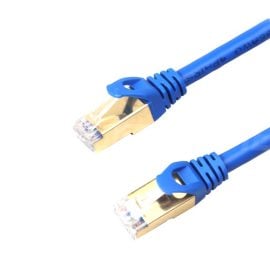Blog, Network Cabling
Pure Copper vs CCA (Copper-Clad Aluminum) Ethernet Cable: How to Choose?
Have you ever purchased an Ethernet cable at a low price, only to have it frequently perform poorly or fail? You most likely bought Copper-Clad Aluminum (CCA) cable, which vendors sometimes sell as category cable. Still, many countries prohibit labeling CCA as a Cat cable. Although the price is attractive, CCA cable is inferior to pure copper cables in terms of performance, longevity, and even safety concerns. This article will compare pure copper vs CCA Ethernet cable to help you make the right choice.
Table of contents
What is CCA cable?
The central conductor of a CCA cable is a high-purity aluminum wire covered with a thin layer of copper. CCA is generally produced for ease of transport and cost reduction and is an economical alternative to pure copper cables. However, it performs poorly, does not meet the requirements of many specialized applications, and is a non-standard cable.

What Is Pure Copper Cable?
Pure copper cables are made from pure copper and offer superior performance and safety compared to CCA. They also meet industry standards for Ethernet and electrical applications.
Pure Copper Cable Types
1. Solid Copper Cable
The conductor is a single copper wire with a solid cross-section. It has good conductivity, is simple to process, and is resistant to stretching. However, its bending ability is not as good as that of stranded copper, which is suitable for static environment wiring. For example, our common power and Ethernet cables use solid copper wire, and communication cables generally require solid copper conductors.

2. Stranded Copper Cable
The conductor is made of multiple strands of small-diameter copper wire stranded, with good flexibility; conductivity is only slightly inferior to solid copper, suitable for jumper cables or dynamic environments. For example, cell phone charging cables, headphone cables, etc.

Pure Copper vs CCA Cable: What Is The Difference?
1. Material and durability
Pure copper cable: Copper is excellently ductile, can withstand multiple bending, is suitable for complex wiring needs, and is durable and ideal for long-term use.
CCA cable: Aluminum has poor ductility, is easy to crack due to bending or force, and is not resistant to high temperatures. A thin layer of copper wrapped around aluminum improves the wire’s oxidation resistance to a certain extent. However, it is still not as good as pure copper cables.
2. Performance
Pure copper cable: With its low resistance and superior conductivity, copper is recognized as a high-quality conductor that ensures signal transmission stability over long distances. It suits high-load applications, including high-speed networks and PoE (Power over Ethernet).
CCA cables: Aluminum has higher resistance and only about 60% of the conductivity of copper. Although covering a small portion of copper improves the conductivity, it is still significantly inferior to pure copper. CCA is prone to signal degradation, especially over long distances and in high-load applications where poor signals may lead to data loss.
3. safety and industry standards
Pure copper cable: Pure copper has a very low electrical resistance, meaning a lot of heat does not build up in the cable. It also has good thermal conductivity to dissipate heat quickly. Therefore, the risk of overheating in pure copper cables is extremely low. Many industry standards require pure copper conductors for communications cables, including the National Electrical Code, UL 444, CSA 22.2, TIA 568C.2, and ISO/IEC 11801 ed 2.2.
CCA Cable: It does not meet industry standards such as NEC, UL444, TIA, etc. Aluminum has a 55% higher resistance than copper and tends to accumulate heat when transferring current. Aluminum is also not as thermally conductive as copper and does not dissipate heat as quickly. The cable may overheat or catch fire if CCA is used for PoE. In some areas where NEC or TIA standards are necessary, the use of CCA may face fines or lawsuits.
4. Cost
CCA cables are cheap to purchase and have a low initial cost; however, high failure rates and later replacement or maintenance needs may lead to increased costs.
Pure copper cables are more expensive to purchase, but they offer good reliability and durability and are cost-effective in the long term.
5. Application Scenarios
CCA cable is suitable for static wiring environments that do not require frequent bending or moving of cables, short distances, low-performance requirements, or short-term usage scenarios. And remember, it cannot be used for PoE!
Pure copper cables are widely used in most scenarios, including network cabling, PoE, audio and video transmission, power transmission, outdoor harsh environments, and more. They can provide a safe and stable solution in home, commercial, or industrial scenarios.
How to Recognize CCA Cable vs Copper Cable
1. Appearance Inspection
Check the cable shell markings: “CU” means pure copper cable, and “CCA” means copper-clad aluminum cable. Standards that the cable complies with, such as “ANSI/TIA” are also marked on it. If the cable is not marked, it may be a deliberate attempt to hide its material problem; stay away from it.

2. Weight Comparison
Pure copper cables are denser and much heavier than CCA cables.
3. Physical Checkup
Peel back the cable insulation and observe the cross-section of the conductor. The center conductor of CCA has a silver aluminum core, and the center conductor of pure copper cable has a yellow copper core. You can also scrape the surface of the conductor with a hard object. After scraping, the surface of the CCA conductor will show the silver wire inside.
Precautions
1. Avoid the low price trap. Too low a price may mean the cable uses inferior materials (such as CCA disguised as pure copper).
2. Beware of false advertising. “High-quality CCA with performance comparable to pure copper” is false advertising.
3. Beware of false labeling. There is no TIA/EIA-compliant CCA such as CCA cat5e or CCA cat6; some manufacturers and vendors will mislead consumers by labeling CCA cables compliant cat Ethernet cables.
4. Choose a brand or supplier you can trust to match.
This is the easiest way to avoid buying a CCA Ethernet cable. The good news is that we use high-quality wires made of pure copper. Optcore has never sold Ethernet cables made of CCA and never will. The Ethernet cables we offer are TIA/EIA standard pure copper, and you can have complete confidence in the Ethernet cables you purchase from us.
-
Cat6 Ethernet Network Patch Cable, Snagless Unshielded (UTP), PVC, Blue
Price range: US$ 0.85 through US$ 13.10 (Excl. VAT) -
Cat5e Snagless Unshielded (UTP) Ethernet Network Patch Cable, PVC, Blue
-
Cat6 Snagless Shielded (SFTP) Ethernet Network Patch Cable, PVC, Blue
Price range: US$ 1.29 through US$ 17.70 (Excl. VAT)
FAQs
1. Will CCA cables affect the life of my equipment?
Yes. Due to the high resistance and overheating issues of CCA cables, especially in PoE applications, they can put extra strain on the power supply devices such as switches, routers, etc. They may shorten the life of the equipment.
2. What can I do if I am using CCA cable?
To reduce the failure rate in the short term, reduce the load or lower the frequency of use. In the long term, it is recommended that you replace the cable with a compliant cable.
3. If the budget is minimal, what should I choose?
If your budget is minimal, you can choose pure copper cables with a small cross-section (e.g., Cat5e). This cable type is cost-effective and better balances cost and performance. For more information, please refer to our article: ‘Cat5, Cat5e, Cat6, Cat6a, Cat7, Cat7a vs. Cat8 Ethernet Cable: What is the difference? ‘
Conclusion
Pure copper cable is superior to CCA cable in performance, durability, safety, and industry compliance. While the low price of CCA cable may give the illusion of cost savings, the high failure rate and performance issues make it unsuitable for most specialized applications. It is crucial to avoid choosing twisted pair Ethernet cables that use CCA; it’s good to go with a pure copper one.
Reference:









